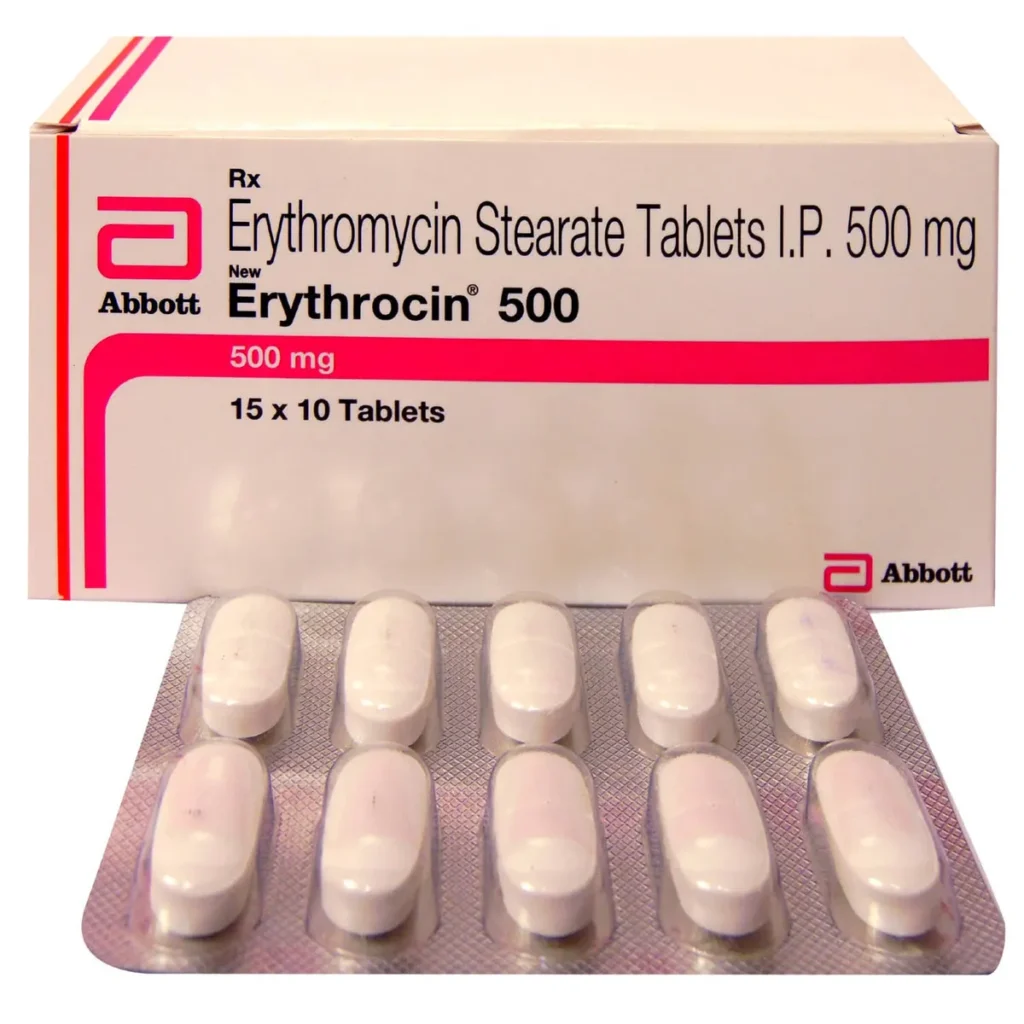Erythromycin is a widely used antibiotic that belongs to the macrolide class of antimicrobials. Discovered in 1952, it has since played a significant role in the treatment of various bacterial infections. The drug is effective against a range of Gram-positive bacteria and some Gram-negative bacteria, making it a valuable agent in both outpatient and hospital settings.

- Introduction to Erythromycin
Erythromycin is a macrolide antibiotic produced by Saccharopolyspora erythraea (originally known as Streptomyces erythraeus). It works primarily by inhibiting bacterial protein synthesis, which halts the growth and proliferation of bacteria.https://todayliv.com/
Its spectrum is especially potent against Gram-positive organisms, including Streptococcus and Staphylococcus species, and some Gram-negative bacteria like Haemophilus influenzae and Neisseria gonorrhoeae. Because of its relatively broad coverage and oral bioavailability, erythromycin has been used extensively across various medical fields.
- Mechanism of Action
Erythromycin acts by binding to the 50S subunit of the bacterial ribosome. This binding inhibits the translocation step in protein synthesis, effectively stopping the bacteria from growing. Unlike bactericidal antibiotics (which kill bacteria), erythromycin is bacteriostatic, meaning it inhibits bacterial growth and allows the immune system to clear the infection.
- Common Uses of Erythromycin
3.1. Respiratory Tract Infections
One of the most common uses of erythromycin is in the treatment of upper and lower respiratory tract infections, including:
Pharyngitis and Tonsillitis: Often caused by Streptococcus pyogenes, erythromycin is used when patients are allergic to penicillin.
Pneumonia: Especially atypical pneumonia caused by Mycoplasma pneumoniae, Legionella pneumophila, or Chlamydia pneumoniae.
Pertussis (Whooping Cough): Erythromycin is a first-line treatment for Bordetella pertussis infections.
Sinusitis and Otitis Media: Caused by Streptococcus pneumoniae or H. influenzae, erythromycin can be used in mild to moderate cases.
3.2. Skin and Soft Tissue Infectionshttps://todayliv.com/
Erythromycin is useful in treating infections caused by staphylococcal and streptococcal species:
Impetigo
Cellulitis
Erysipelas
Acne vulgaris: Often used topically as a gel or lotion, erythromycin reduces Cutibacterium acnes proliferation and inflammation.
3.3. Gastrointestinal Infections
Though not commonly used for this purpose now due to resistance, erythromycin has historically treated infections like:
Campylobacter enteritis
Cholera
Diphtheria: Erythromycin is effective against Corynebacterium diphtheriae and is often used for treatment and prophylaxis.
3.4. Sexually Transmitted Infections (STIs)
Erythromycin is used in the management of:
Chlamydia trachomatis: Particularly in infants (ophthalmia neonatorum) and during pregnancy when tetracyclines are contraindicated.
Syphilis: An alternative in penicillin-allergic patients, though not as effective.
Gonorrhea: Sometimes used in conjunction with other antibiotics.
3.5. Ophthalmic Infections
Erythromycin eye ointment is commonly used to treat and prevent eye infections in newborns, especially:
Neonatal conjunctivitis
Prophylaxis of ophthalmia neonatorum caused by N. gonorrhoeae or C. trachomatis
3.6. Prokinetic Use in Gastroparesis
At low doses, erythromycin acts as a motilin receptor agonist, stimulating gastrointestinal motility. It is used off-label to manage:
Gastroparesis, particularly in diabetic patients
Delayed gastric emptying post-surgery
This is not an antimicrobial use, but it highlights erythromycin’s versatility.
- Formulations and Routes of Administration
Erythromycin is available in several formulations:
Oral tablets and capsules (e.g., erythromycin base, ethylsuccinate, estolate, and stearate)
Intravenous formulations
Topical gels, lotions, and creams
Ophthalmic ointments
Each formulation is tailored to specific types of infections and patient needs. For example, the estolate form is often preferred for pediatric use due to better taste and absorption.
- Use in Special Populations
5.1. Pediatric Use
Erythromycin is extensively used in children for conditions like:
Pertussis
Neonatal conjunctivitis
Streptococcal pharyngitis in penicillin-allergic children
5.2. Use in Pregnancy and Lactationhttps://todayliv.com/
Erythromycin is considered relatively safe in pregnancy (FDA Pregnancy Category B). It is often used when other drugs like tetracyclines or fluoroquinolones are contraindicated.
- Side Effects and Adverse Reactions
While generally safe, erythromycin can cause several adverse effects:
6.1. Gastrointestinal Effects
Nausea
Vomiting
Diarrhea
Abdominal cramps
These are the most common side effects, especially at higher doses.
6.2. Hepatotoxicity
Cholestatic hepatitis, particularly with the estolate formulation
6.3. Cardiac Effects
QT prolongation and risk of torsades de pointes, particularly when combined with other QT-prolonging agents
6.4. Hypersensitivity Reactions
Rash
Fever
Rarely, anaphylaxis
6.5. Drug Interactions
Erythromycin inhibits cytochrome P450 3A4, which can lead to dangerous interactions with drugs like:
Statins (risk of rhabdomyolysis)
Warfarin (increased bleeding risk)
Theophylline
Carbamazepine
- Resistance to Erythromycin
The increasing emergence of erythromycin resistance is a significant concern. Resistance mechanisms include:
Target site modification (methylation of 23S rRNA)
Efflux pumps that expel the antibiotic from bacterial cells
Enzymatic inactivation
Bacteria like Streptococcus pneumoniae and Staphylococcus aureus have shown increasing resistance, leading to decreased clinical utility in some regions. This has led to a shift toward newer macrolides (e.g., azithromycin, clarithromycin) and other antibiotic classes.
- Erythromycin vs. Other Macrolides
Newer macrolides like azithromycin and clarithromycin have largely replaced erythromycin in many clinical scenarios due to:
Better tissue penetration
Longer half-lives
Fewer GI side effects
More convenient dosing
However, erythromycin remains relevant in several contexts, especially in developing countries, resource-limited settings, and patients with specific allergies.
- Global and Historical Impact
Erythromycin was one of the first antibiotics with broad utility in respiratory, dermal, and systemic infections. It played a vital role in managing infections in the pre-penicillin allergy testing era.
Even today, erythromycin is listed on the WHO Essential Medicines List, underscoring its enduring value in global health.
- Conclusion
Erythromycin has been a cornerstone antibiotic for decades. Despite being overshadowed by newer macrolides and other antibiotic classes, it continues to play a significant role in:
Treating respiratory, skin, and soft tissue infections
Managing STIs in penicillin-allergic individuals
Providing an option for pediatric and pregnant patients
Stimulating gastric motility in GI disorders
As antimicrobial resistance patterns evolve, the judicious use of erythromycin remains crucial. Its effectiveness, affordability, and versatility ensure that it maintains a place in both modern and traditional therapeutic regimens.https://todayliv.com/